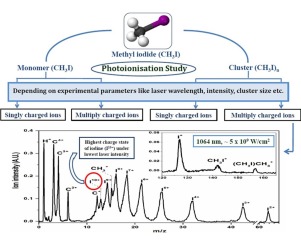Journal of Photochemistry and Photobiology C: Photochemistry Reviews ( IF 12.8 ) Pub Date : 2017-09-21 , DOI: 10.1016/j.jphotochemrev.2017.09.002 Soumitra Das , Pramod Sharma , Rajesh K. Vatsa

|
Methyl iodide (CH3I) is one of the most studied molecule in the field of photochemistry. This molecule has been investigated by a variety of light sources including lamps, different lasers as well as synchrotron radiation of varying intensity and wavelength. In this review, photoionisation studies of CH3I have been summarised for monomer (CH3I) and its aggregates i.e., cluster (CH3I)n which were excited with a range of photon energy and intensity using different sources. For the case of monomer, ionisation process follows either ionisation followed by dissociation (ladder climbing mechanism) or dissociation followed by ionisation (ladder switching mechanism) depending upon the wavelength and intensity of ionisation source. In case of CH3I ionisation by synchrotron radiation, singly and doubly charged molecular ions were observed depending upon the energy of photon. For ionisation using laser sources, singly and multiply charged ions were observed for laser pulses ranging from femtosecond to nanosecond duration. For the case of cluster (CH3I)n ionisation with laser sources, multiply charged ions were observed leading to Coulomb explosion phenomena. Lowest possible laser intensity observed to induce Coulomb explosion in CH3I clusters was ∼109 W/cm2 using nanosecond laser pulses. Since observation of multiply charged ion at gigawatt intensity is surprising, a detailed description of experimental results has been summarised. A three stage cluster ionisation model which comprises of multiphoton ionization ignited-inverse Bremsstrahlung heating and electron ionization has been adapted to explain experimental observations and to understand nanosecond laser induced Coulomb explosion of CH3I clusters.
中文翻译:

在气相中追踪甲基碘的光电离行为:从分离的分子到分子聚集体
碘甲烷(CH 3 I)是光化学领域中研究最多的分子之一。已通过各种光源(包括灯,不同的激光以及强度和波长不同的同步加速器辐射)研究了该分子。在这篇综述中,对CH 3 I的光电离研究进行了总结,涉及单体(CH 3 I)及其聚集体,即簇(CH 3 I)n使用不同的光源,它们在一定范围的光子能量和强度下被激发。就单体而言,取决于电离源的波长和强度,在电离过程之后进行电离,然后进行离解(梯子爬升机制),或者进行离解后进行电离(梯子切换机制)。在通过同步加速器辐射使CH 3 I电离的情况下,根据光子的能量,观察到单电荷和双电荷分子离子。对于使用激光源的电离,对于飞秒至纳秒级的激光脉冲,观察到单电荷离子和多电荷离子。对于簇(CH 3 I)n用激光源电离时,观察到带多个电荷的离子,导致库仑爆炸现象。使用纳秒激光脉冲,观察到的在CH 3 I团簇中引起库仑爆炸的最低激光强度约为10 9 W / cm 2。由于在千兆瓦强度下观察多电荷离子是令人惊讶的,因此对实验结果进行了详细描述。包括多光子电离点燃-反向Bre致辐射加热和电子电离的三阶段团簇电离模型已被用来解释实验观察结果和了解CH 3 I团簇的纳秒激光诱导库仑爆炸。











































 京公网安备 11010802027423号
京公网安备 11010802027423号